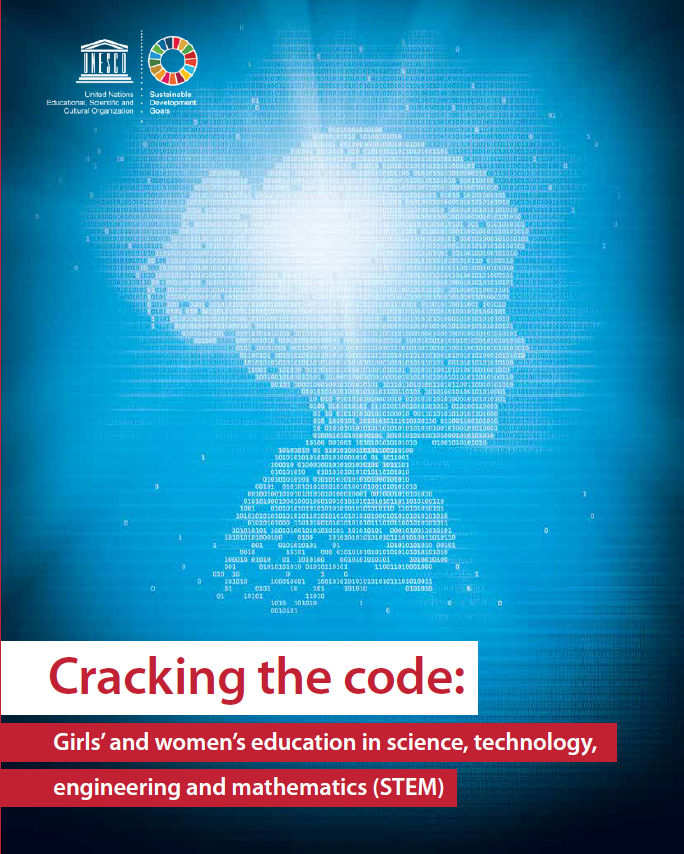Cracking the code : Girls’ and women’s education in science, technology, engineering and mathematics (STEM)
Abstract
This report aims to ‘crack the code’, or to decipher the factors that hinder or facilitate girls’ and women’s participation, achievement and continuation in STEM education, and what can be done by the education sector to promote girls’ and women’s interest in, and engagement with, STEM. Gender differences in STEM education participation at the expense of girls are already visible in early childhood care and education (ECCE) and become more visible at higher levels of education. Girls appear to lose interest in STEM subjects with age, and lower levels of participation are already seen in advanced studies at secondary level. By higher education, women represent only 35% of all students enrolled in STEM-related fields of study. Gender differences also exist in STEM disciplines, with the lowest female enrolment observed in information, communication and technology (ICT); engineering, manufacturing and construction; and natural science, mathematics and statistics. Women leave STEM disciplines in disproportionate numbers during their higher education studies, in their transition to the world of work and even during their career cycle. Cross-national studies of learning achievement (measuring knowledge acquisition or knowledge application) from more than 120 countries and dependent territories present a complex picture. In middle- to high-income countries for which trend data are available, data gaps to girls’ disadvantage are closing, particularly in science. In addition, in countries where girls do better than boys on curriculum-based assessments, their score difference can be up to three times higher than when boys do better. There are significant regional differences, however. For example, girls outperform boys in many countries in Asia while the score difference between boys and girls in science achievement is particularly strong in the Arab States, with girls significantly outperforming boys. More countries demonstrate gender differences to boys’ advantage in mathematics achievement, with boys’ score differentials as compared to those of girls often increasing between early and late primary education. Regional differences exist also in mathematics; girls are particularly disadvantaged in Latin America and sub-Saharan Africa. Differences also exist between assessments that measure learning against the curriculum-based compared to those that measure students’ ability to apply knowledge and skills to different situations. Boys performed better in two-thirds of the 70 countries measuring applied learning in math at age 15. esearch on biological factors, including brain structure and development, genetics, neuroscience and hormones, shows that the gender gap in STEM is not the result of sex differences in these factors or in innate ability. Rather, findings suggest that learning is underpinned by neuroplasticity, the capacity of the brain to expand and form new connections, and that education performance, including in STEM subjects, is influenced by experience and can be improved through targeted interventions. Spatial and language skills, especially written language, are positively correlated with performance in mathematics and can be improved with practice, irrespective of sex, especially during the earlier years of life. Cracking the code: Girls’ and women’s education in science, technology, engineering and mathematics (STEM). These findings highlight the need to look at other factors to explain gender differences in STEM. Studies suggest that girls’ disadvantage in STEM is the result of the
interaction of a range of factors embedded in both the socialisation and learning processes. These include social, cultural and gender norms, which influence the way girls and boys are brought up, learn and interact with parents, family, friends, teachers and the wider community, and which shape their identity, beliefs, behaviour and choices. Self-selection bias, when girls and women chose not to pursue STEM studies or careers, appears to play a key role. However, this ‘choice’ is an outcome of the socialisation process and stereotypes that are both explicitly and implicitly passed on to girls from a young age. Girls are often brought up to believe that STEM are ‘masculine’ topics and that female ability in this field is innately inferior to that of males. This can undermine girls’ confidence, interest and willingness to engage in STEM subjects. Evidence shows that girls’ self-efficacy and attitudes related to STEM are strongly influenced by their immediate family environment, especially parents, but also the wider social context. Parents’ own beliefs, attitudes and expectations are themselves influenced by gender stereotypes, which can cause differential treatment of girls and boys in care, play and learning experiences. Mothers, more than fathers, appear to have a greater influence on their daughters’ education and career choices, possibly due to their rolemodel function. Parents with higher socio-economic status and higher educational qualifications tend to have more positive attitudes towards STEM education for girls than parents with lower socio-economic status and education, of immigrant status and ethnic minority background or single parents. Media representations of women, and the status of gender equality in society also has an important influence, as it influences the expectations and status of women, including in STEM careers.


